PLC and proximity and photoelectric switch wiring method - Database & Sql Blog Articles
I. Introduction
The digital input interface of plc is not complicated. We all know that in order to improve the anti-interference ability of PLC, the input interface uses optocoupler to isolate the transmission of input signal and internal processing circuit. Therefore, the signal at the input end only drives the internal LED of the photocoupler to be turned on, and is received by the photocoupler of the photocoupler, so that the external input signal can be reliably transmitted.
At present, the PLC digital input port is generally divided into single-ended common point and double-ended input. The single-ended common point (Com) interface of each manufacturer has a common point of the positive coupler and the negative electrode of the photocoupler, and the Japanese PLC usually adopts the common point of the positive electrode. European-based PLCs are accustomed to adopting a negative common point; Japanese PLC supply to the European market is also based on the common habit of the negative point in Europe; in order to be flexible, it has developed a single-ended common point (S/S) optional type, which is required to be single-ended at the same time. It can be connected to the negative pole or to the positive pole.
Due to these differences, the user needs to distinguish and understand when selecting an external sensor in order to correctly use the sensor and PLC to lay the foundation for later programming work and system stability.
Two: the form of the input circuit
1, the classification of the input type
The digital input terminal of PLC is divided into DC and AC according to the power supply. It is classified into single-ended common input and double-ended input according to the input interface. The single-ended common-point power supply positive is SINK (sink current), single-ended common point connection The negative pole of the power supply is SRCE (source current).

2. Explanation of terms
SINK leak type
SOURCE source type
The SINK leakage type is the current flowing from the input terminal, then the input terminal is connected to the negative pole of the power supply, indicating that the photocoupler inside the interface is a single-ended common point for the positive pole of the power supply, and can be connected with the NPN type sensor.
The SOURCE source type is the current flowing from the input end, then the input end is connected to the positive pole of the power supply, indicating that the photocoupler inside the interface is a single-ended common point as the negative pole of the power supply, and can be connected to the PNP type sensor.
There are various expressions of domestic sayings about these two methods:
1) According to TI's definition, sink current is the current drawn, and source current is the sink current.
2), the polarity of the single-ended common point by the interface, the common positive electrode and the common negative electrode. Such expressions are easier to distinguish.
3), SINK is NPN connection, SOURCE is PNP connection (according to the output form of the sensor).
4), SINK is a negative logic connection, and SOURCE is a positive logic connection (in terms of the output form of the sensor).
5), SINK is the active low level of the sensor, and SOURCE is the active high level of the sensor (according to the expression of the output state of the sensor).
The author of this expression has the most contact and is the most confusing.
The proximity switch and the photoelectric switch have three- and four-wire output points NPN and PNP output. For the non-detection signal, the NPN proximity switch and the photoelectric switch output are at a high level (for the internal pull-up resistor), when there is a detection signal, the internal The NPN tube is turned on and the switch output is low.
For the non-detection signal, the PNP proximity switch and the photoelectric switch output are low (for the internal pull-down resistor), when there is a detection signal, the internal PNP tube is turned on, and the switch output is high.
The above situation is only for the sensor, which is in a normally open state. At present, the sensors that can be produced by the manufacturer are normally open and normally closed; the normally closed NPN output is low, and the normally closed PNP output is high. Therefore, the user often has a deviation in matching with the supplier in the selection.
In another case, the user also encounters SINK connected to the PNP type sensor, the SOURCE is connected to the NPN type sensor, and can also drive the PLC interface. The PLC input signal status is modified by the PLC program. The reason is that the sensor output has a pull-up resistor and a pull-down resistor. For the open-collector sensor, such connection is invalid; in addition, the output pull-up resistor and pull-down resistor value and PLC interface leakage current parameter are very large. relationship. Not all sensors and PLCs can be used universally. For such problems, please refer to the author's other article, "Proximity Switch, Photoelectric Switch Output and Load Interface Problems", which will not be repeated here.
The SINK leak type and SOURCE source type are described in detail below.
3, according to the power configuration type
3.1, DC input circuit
As shown in Figure 1, the DC input circuit requires the external input signal component to be a passive dry contact or a DC active contactless switch contact. When the external input component is turned on with the positive supply of the power supply, the current passes through R1, the internal LED of the optocoupler, VD1 (interface indication) forms a loop to the COM end, and the internal receiving tube of the optocoupler receives the signal of the external component conduction, and transmits it to the internal processing; the interface mode for supplying power from the DC power is called the DC input circuit; the DC power can be internally generated by the PLC. It provides components that can also be supplied with an external input signal from an external DC power supply. The role of R2 in the circuit is to bypass the current of the LED inside the optocoupler, ensuring that the optocoupler LED is not turned on by the static leakage current of the two-wire proximity switch.
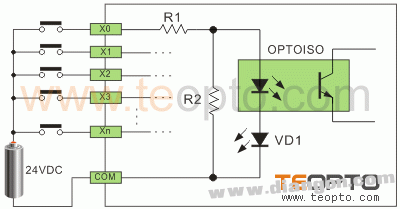
3.1. AC input circuit As shown in Figure 2, the AC input circuit requires the external input signal component to be a passive dry contact or an AC active contactless switch contact. The difference between the DC input interface and the DC interface is increased by one step in front of the optocoupler. Voltage circuit and bridge rectifier circuit. After the external components are connected to the AC power, the current is rectified through the bridge through R1 and C2, and becomes the DC current after the step-down. The principle of the subsequent circuit is consistent with the DC. The AC PLC is mainly suitable for occasions where the relative environment is bad, and the wiring technology changes little. If the proximity switch is used, the AC line is directly replaced by the original line switch.

4: According to the port type 4.1 single-ended common point (Comcon) digital input mode In order to save the input terminal, the structure of the single-ended common point input is to connect one end of all input circuits (photocouplers) to the inside of the PLC. For COM's internal common terminal (internal comcon terminal), the other end of each input circuit is connected to its corresponding input terminal X0, X1, X2, ..., com and N single-ended inputs. A digital input (N+1 terminals), so we call this structure a "single-ended common point" input.
The user also needs to do the same thing when wiring the external digital input components. It is necessary to connect one end of all input components together, called the external comcon wire of the input component; the other end of the input component is connected. Input terminals X0, X1, X2, .... of the PLC.
If COM is 24V+ (positive), the external collinear connection should be connected to 24V-(negative). This connection is called SINK (sink current) input mode; also known as PLC interface common power positive.
If COM is 24V- (negative), the external collinear connection should be connected to 24V+ (positive). This connection is called SRCE (source current) input mode; also known as PLC interface common power supply negative.
SINK (sink Current) input mode, can be connected to the NPN type sensor, that is, the X port is connected to the negative pole.
SRCE (source current sinking) input mode, can be connected to PNP type sensor. That is, the X port is connected to the entire pole.
In order to adapt to the usage habits of various regions, some PLCs of internal common terminals use S/S terminals, which can be connected with 24V+ (positive) or 24V- (negative) of the power supply, and the PLC can be combined with external collinear wiring changes. SINK (sink Current) input mode, can be connected to NPN type sensor and SRCE (source Current sinking) input mode, can be connected to PNP type sensor. More flexible than PLC with COM. The development of the S/S terminal is used for the industrial control occasions in which the Japanese and European PLCs are used in combination, and the S/S terminal is also called the SINK/SRCE switchable type.
(The external input component can be a switch component such as a push button switch, a travel switch, a reed switch, a Hall switch, a proximity switch, a photoelectric switch, a light curtain sensor, a relay contact, and a contactor electric shock.)
4.1.1 SINK (sink Current) input mode ◠Single-ended common point SINK input wiring (internal common terminal COM→24V+, external collinear→24V-). Figure 3:

4.1.2 SRCE (source current sinking) input mode ◠Single-ended common point SRCE input wiring (internal common terminal COM → 24V-, external collinear → 24V +). Figure 4:
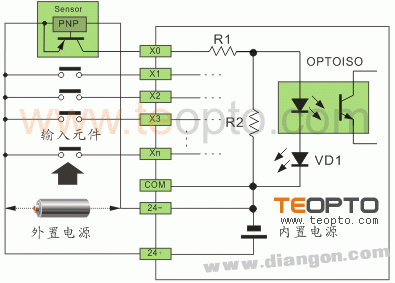
4.1.3 SINK/SRCE Switchable Input Mode The S/S terminal is different from the COM terminal. COM is fixedly connected to the positive or negative terminal of the internal power supply. The S/S terminal is not fixedly connected. It is connected to the internal power supply or external power supply as needed. The positive or negative electrode is connected.
◠Single-ended common point SINK input wiring (internal common point terminal S/S → 24V+, external collinear → 24V-).

◠Single-ended common point SRCE input wiring (internal common point terminal S/S → 24V-, external collinear → 24V+).
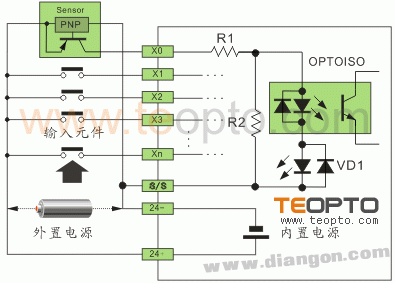
4.2.4: When the number of active input components (Hall switch, proximity switch, photoelectric switch, light curtain sensor, etc.) is relatively large, the power consumption is relatively large, and the PLC built-in power supply cannot be satisfied, the external power supply needs to be configured. According to the demand, it can be equipped with 24VDC, a certain power switching power supply. In principle, the external power supply cannot be connected in parallel with the built-in power supply. According to the characteristics of COM and external collinearity, when the SINK (sink Current) input mode is used, the external power supply is connected to the positive terminal of the built-in power supply; SRCE (source current) input mode When the external power supply is connected to the negative pole of the built-in power supply.
4.2.5: Simply judge the SINK (sink Current) input mode, only need to short-circuit the Xn terminal and the negative terminal. If the interface indicator is on, it means the SINK input mode. A common positive photocoupler can be connected to an NPN type sensor. The SRCE (source current) input mode shorts the Xn terminal to the positive terminal. If the interface indicator is on, it indicates the SRCE input mode. A common negative photocoupler can be connected to a PNP type sensor.
4.2.4: For 2-wire digital input, if it is a passive contact, SINK and SRCE are connected according to the input component of the above figure. For the 2-wire proximity switch, it is necessary to judge the polarity of the proximity switch and connect correctly. In. Some of the 2-wire LJK series proximity switches of our company can also be connected to the interface without polarity. For details, please refer to the attached product manual.
4.2. The ultra-high-speed double-ended input circuit is mainly used for the input of the hardware high-speed counter (HHSC). The interface voltage is 5VDC. In order to ensure high speed and high noise resistance, the line-drive method is usually adopted. If the operating frequency is not high and the noise is low, 5VDC single-ended SINK or SRCE connection can be used, and a current limiting resistor in series can be converted into a 24VDC single-ended SINK or SRCE connection.
4.2.1, two-input two-line drive (Line-Drive).

4.2.2, 5VDC single-ended SINK or SRCE connection.
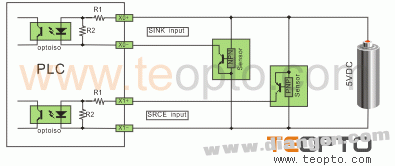
4.2.3, 24VDC single-ended SINK or SRCE connection.

Note: 24VDC power supply sensor requires series current limiting resistor on the input circuit. R1 is 10Ω, R2 is 2KΩ, no series current limiting resistor will be used, and the interface circuit will be burned. The current limiting resistor has a value of 2.7KΩ.
Four: external input components
1: Passive dry contact (button switch, travel switch, reed magnetic switch, relay contact, etc.)
Passive dry contacts are relatively simple and easy to wire. There are no factors such as the polarity of the power supply, voltage drop, etc., which is the input component in Figure 3-6 above. This is not repeated here.
2: Active two-wire sensor (proximity switch, active reed magnetic switch)
The active two-wire proximity switch is divided into DC and AC. The characteristic of this sensor is two wires. After the output of the transmitter is turned on, in order to ensure the normal operation of the circuit, a holding voltage is required to maintain the circuit operation, usually at a voltage drop of 3.5-5V. The static leakage current is less than 1 mA. This indicator is very important. If it is too large, the photocoupler at the input of the PLC is turned on when the proximity switch does not detect the signal. Our company's LJK series two-wire proximity switch static leakage current control is suitable for various types of PLC between 0.35-0.5mA.
DC two-wire proximity switch sub-diode polarity protection and bridge rectification polarity protection, the former needs to pay attention to polarity when connecting to PLC, the latter does not need to pay attention to polarity. The active reed magnetic switch is mainly used for position detection on the cylinder. Since the signal indication is required, there is a bidirectional diode circuit inside, so there is no need to pay attention to the polarity; the AC two-wire proximity switch does not need to pay attention to the polarity. Figure 10:
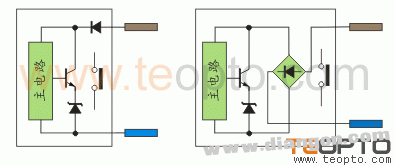
2.1, single-ended common point SINK input wiring (internal common terminal COM → 24V +, external collinear → 24V-). Figure 11
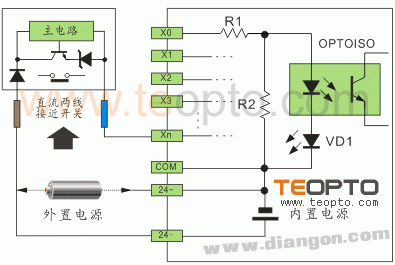
2.2, single-ended common point SRCE input wiring (internal common point terminal COM → 24V-, external collinear → 24V +). Figure 12:

2.3, S / S terminal connection method refer to Figure 5 - Figure 6 and Figure 11 - Figure 12.
3: Active three-wire sensor (inductance proximity switch, capacitor proximity switch, Hall proximity switch, photoelectric switch, etc.)
The DC active three-line proximity switch and the photoelectric switch output tube use the triode output, so the sensor is divided into NPN and PNP output, and some products are four-wire system, with double NPN or double PNP, but the state is just the opposite, and there is also a combination of NPN and PNP. The four-wire output.
NPN type When the sensor has the detection signal VT turned on, the current of the output terminal OUT flows to the negative pole, and the output terminal OUT potential is close to the negative pole. Generally speaking, the high level is turned to a low level.
PNP type When the sensor has the detection signal VT turned on, the current of the positive pole flows to the output terminal OUT, and the potential of the output terminal OUT is close to the positive pole, and the low level is generally said to be turned to a high level.
The resistance on the emitter of the transistor in the circuit is short-circuit protection. The sampling resistor 2-3Ω does not affect the output current. The collector resistance of the triode is a pull-up and pull-down resistor, which provides an output potential for the circuit of the level interface. The other output of the open collector of the triode is not connected with pull-up and pull-down resistors. For more problems, please refer to the proximity switch. , the output of the photoelectric switch and the load interface problem.
Simply put, when the triode VT is turned on, it is quite conductive with a contact, as shown in Figure 13:
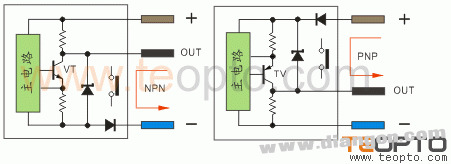
3.1 Single-ended common point SINK input wiring (internal common terminal COM → 24V +, external collinear → 24V-). Figure 14:
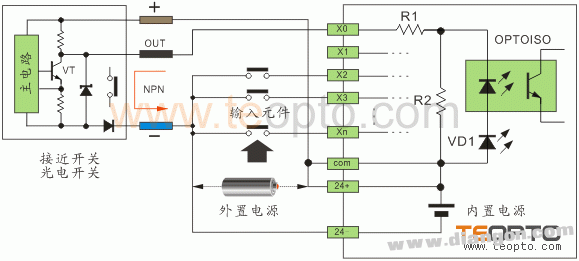
2.2, single-ended common point SRCE input wiring (internal common point terminal COM → 24V-, external collinear → 24V +). Figure 15:
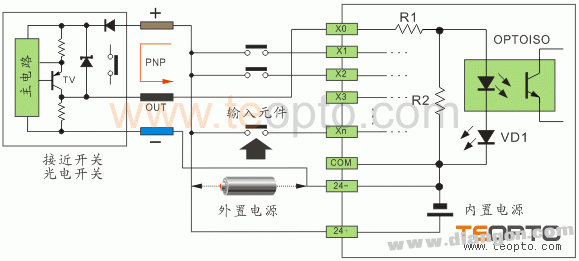
2.3. The S/S terminal connection method refers to FIG. 5 to FIG. 6, FIG. 11 to FIG. 12, and FIG. 14 to FIG.
V. Conclusion
The PLC input interface circuit form and the external signal (sensor) output signal form diversity, so it is necessary to understand the PLC input circuit form and the sensor output signal form before the PLC input module wiring, in order to ensure the PLC input module wiring is correct, in practical application In order to be able to work well, the post-programming work and system stability laid the foundation.
P3.5X6 Automotive Connector
P3.5X6 Automotive
ShenZhen Antenk Electronics Co,Ltd , https://www.antenkconn.com